Peer-to-Peer Lending Is An Old Concept But Recently Became Famous
A disruption in any industry is always met with distrust, if not utter opposition. That’s what happened when Peer-to-Peer lending came onto the scene of the lending marketplace.
Initially, people would take it with a pinch of salt and often attribute it to something shady or a niche market.
Only after the fall of Wall Street in 2008 did investors and borrowers lose their confidence in the traditional banking sector.
Soon they came like a herd of galloping cattle coming to the water pond. Since inflation drew the wedge in running a successful business, SMEs searched for out-of-the-box finance options.
That’s how P2P became an alternative lending option available to borrowers in the UK and worldwide. But that’s not the whole story.
We are going to break down the milestones of the P2P lending concept and try to expand on its current popularity in this article.
A Brief History of Peer-to-Peer Exchange of Value:
P2P lending seems like a new thing, but the basic concept is old. We can relate the primary connections of P2P with the old-age barter system.
Though in a barter system, there wasn’t any money exchange, or more specifically, money wasn’t used to measure the value of goods.
However, as it connects people to people to give and take goods, we can call it the precursor of the peer-to-peer exchange of goods.
Nevertheless, its proper origins started in the late 18th century, much later than the invention of money. In early modern France, people used to lend money for various purposes.
Though banks existed in those days, people still used the informal lending market to proceed with payments, buy land or other miscellaneous activities.
The eye-opening fact behind the massive use of alternative finance was that the total volume of money exchanged between the informal and traditional markets was similar.
It entails that P2P lending was a relatively major thing in the credit lending industry of 18th-century Europe.
Read More: Fix A Broken Property Chain With A Bridging Loan
The re-emergence of P2P lending as a popular lending option:
The banking history shows us terrific consumer finance services spanning centuries. From the start of banking till 2008, banks have been the backbone of economies and have played a critical role in the development of Europe.
The real blind spot appeared in the 2008 market crash. It drew a wedge into the bank-consumer relationship. Suddenly, people lost confidence in the financial institutions regulated by central banks.
Most importantly, banks couldn’t procure loans as they feared defaults. Not having the power to lend money to people and businesses further exacerbated the distrust.
Similarly, SMEs were eager to sustain themselves amid rising living costs. Therefore, people explored new lending options outside the high-street world, such as bridging loans.
By then, Zopa had started its operations into P2P lending but was not getting any tractions from lenders and borrowers. However, the credit crunch brought new investors and borrowers to this side of consumer finance.
The informal market, considered a niche or shady, suddenly got a kickstart as more and more consumers got their loans and investors got their repayments back.
The popularity of P2P lending wasn’t a straight slope. There were several mishaps in the industry, but the growth has been steady.
P2P leaders have envisioned positive growth in the industry in the upcoming years. The biggest advantage this industry gets is technology.
As we know, tech brings people closer to one another and bothers them to innovate new approaches to consumer finance so that we can project a bright future.
According to Allied Market Research, the global P2P market size was $67.93 billion. Surprisingly, these figures would reach $558.91 billion in 2027, with a growth of 29.7%.
These stats are enough to convince us that P2P has a place in transforming the way we think about the future lending marketplace.
The current trend indicates that traditional market leaders are interested in the P2P lending industry.

Similarly, many tech companies, like Alphabet Inc., invested in P2P companies.
It entails that the main stakeholders are interested in the alternative lending market. In a nutshell, peer-to-peer lending is an old concept that recently became famous.
Final Words:
P2P lending platforms are abundant around the world. Several old companies are thriving each day.
Also, new players have flooded the market with better tech innovations that are consumer friendly and socially conscious.
It makes the alternative lending market a good prospect to invest in and borrow money. The recent events have also increased the speed with which people are taking bridging loans UK from specialized lenders.
We have covered a brief analysis of how P2P started and what its prospects were in 18th-century France.
Plus, we have discovered some useful insights about peer-to-peer lending in the current market. If you have read the article, kindly let us know your feedback in the comments.






Comments
Post a Comment